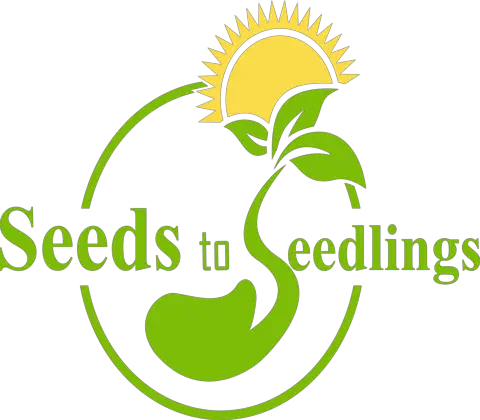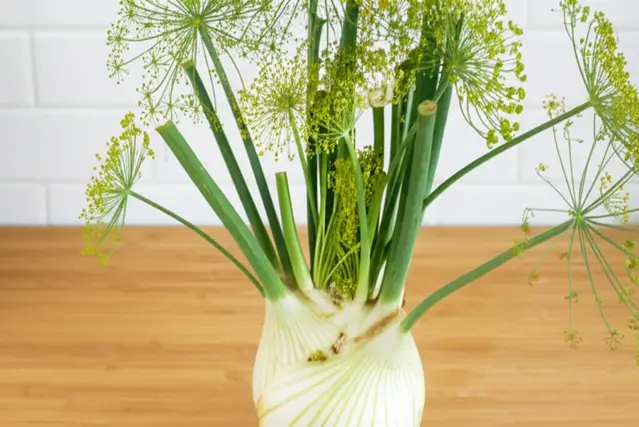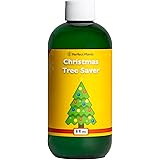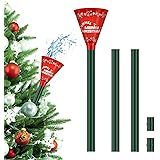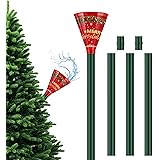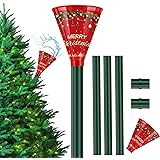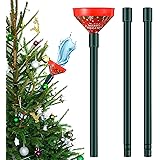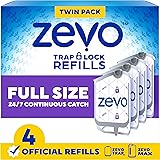Fennel, with its distinctive anise-like flavor, is a versatile herb and vegetable that can elevate your culinary creations. Whether you’re using its feathery fronds in salads, its bulb in roasts, or its seeds as a spice, fresh fennel is a delight. But what if you don’t have a sprawling garden?
Don’t worry! This guide will show you how to successfully grow fennel in a milk jug, a fantastic space-saving and budget-friendly method for enjoying homegrown fennel.
Why Grow Fennel in a Milk Jug?
Growing fennel in a milk jug offers several advantages:
- Space-Saving: Perfect for small spaces like balconies, patios, or even windowsills.
- Cost-Effective: Reuses materials that would otherwise be discarded, reducing waste and saving money.
- Portability: Easy to move the plant to optimize sunlight exposure or protect it from harsh weather.
- Beginner-Friendly: A simple and manageable project for gardeners of all skill levels.
- Educational: A great way to teach children about gardening and plant life cycles.
Understanding Fennel: A Quick Overview
Before we dive into the specifics of growing fennel in a milk jug, let’s understand the plant itself. Fennel (Foeniculum vulgare) is a perennial herb, though it’s often grown as an annual, especially bulb fennel. There are two main types:
- Bulb Fennel (Florence Fennel): Grown for its swollen bulb at the base, which has a mild anise flavor.
- Herb Fennel (Common Fennel): Grown for its feathery leaves and seeds, which have a stronger anise flavor.
For milk jug gardening, both types can be grown, but bulb fennel might eventually outgrow the container, requiring transplanting to a larger pot or garden bed. Herb fennel is generally better suited for long-term container growing.
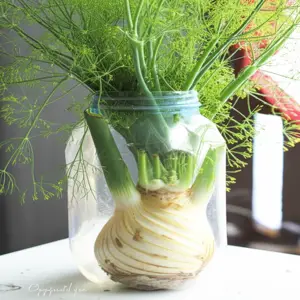
Materials You’ll Need
Gather these materials before you start:
- Milk Jug: A clean, empty milk jug (or any similar-sized plastic container).
- Fennel Seeds: Purchase high-quality fennel seeds from a reputable source.
- Potting Soil: Use a well-draining potting mix suitable for herbs and vegetables.
- Drill or Sharp Knife: For creating drainage holes in the milk jug.
- Watering Can or Spray Bottle: For watering the seedlings.
- Optional: Seed starting tray or small pots for starting seeds indoors.
Step-by-Step Guide: Growing Fennel in a Milk Jug
Follow these steps to successfully grow fennel in your milk jug container:
Step 1: Prepare the Milk Jug
- Clean the Milk Jug: Thoroughly wash the milk jug with soap and water to remove any residue.
- Create Drainage Holes: Drill or carefully cut several drainage holes in the bottom of the milk jug. This is crucial to prevent waterlogging, which can lead to root rot.
- Cut the Top (Optional): You can cut off the top portion of the milk jug to create a wider opening for planting and easier access for watering. This is optional but often recommended.
Step 2: Sow the Fennel Seeds
You have two options for starting your fennel seeds:
- Direct Sowing: Sow the seeds directly into the milk jug. This is simpler but might result in a lower germination rate.
- Starting Seeds Indoors: Start the seeds indoors in a seed starting tray or small pots. This gives the seedlings a head start and allows you to select the strongest ones for transplanting.
If Direct Sowing:
- Fill the Milk Jug: Fill the milk jug with potting soil, leaving about an inch of space at the top.
- Sow the Seeds: Sprinkle the fennel seeds evenly over the surface of the soil.
- Cover the Seeds: Lightly cover the seeds with a thin layer of soil (about ¼ inch).
- Water Gently: Water the soil gently using a watering can or spray bottle. Make sure the soil is moist but not waterlogged.
If Starting Seeds Indoors:
- Fill Seed Trays or Pots: Fill your seed starting tray or small pots with potting soil.
- Sow the Seeds: Sow 2-3 fennel seeds per cell or pot.
- Cover the Seeds: Lightly cover the seeds with a thin layer of soil.
- Water Gently: Water the soil gently and keep it consistently moist.
- Provide Light: Place the seed tray or pots in a warm, sunny location or under a grow light. Ensure they get at least 6-8 hours of light per day. You might even consider using a SAD light to help with early growth, especially if you’re starting seeds indoors during the winter months.
Step 3: Germination and Early Growth
Fennel seeds typically germinate in 7-14 days. Keep the soil consistently moist but not waterlogged. Once the seedlings emerge, thin them out, leaving only the strongest one or two seedlings per milk jug (if direct sowing) or per pot (if starting indoors).
Step 4: Transplanting (If Starting Seeds Indoors)
Once the seedlings have developed a few sets of true leaves (usually after 4-6 weeks), they are ready to be transplanted into the milk jug.
- Prepare the Milk Jug: Fill the milk jug with potting soil, leaving about an inch of space at the top.
- Carefully Remove the Seedlings: Gently remove the seedlings from the seed tray or pots, being careful not to damage the roots.
- Plant the Seedlings: Create a small hole in the soil in the milk jug and carefully place the seedling in the hole. Gently backfill with soil.
- Water Thoroughly: Water the soil thoroughly after transplanting.
Step 5: Ongoing Care
Fennel requires regular care to thrive. Here’s what you need to do:
- Sunlight: Fennel needs at least 6-8 hours of sunlight per day. Place the milk jug in a sunny location.
- Watering: Water regularly, keeping the soil consistently moist but not waterlogged. Check the soil moisture by sticking your finger into the soil. If the top inch feels dry, it’s time to water.
- Fertilizing: Feed your fennel plant with a balanced liquid fertilizer every 2-4 weeks. You can even look into the best homemade liquid fertilizer for indoor plants for organic options.
- Pest Control: Monitor your plant for pests such as aphids, spider mites, and caterpillars. Treat infestations promptly with insecticidal soap or neem oil.
- Weeding: Remove any weeds that may grow in the milk jug to prevent competition for nutrients and water.
- Support (Optional): As the plant grows taller, you may need to provide support to prevent it from flopping over. You can use a small stake or trellis.
Tips for Success
Here are some additional tips to help you successfully grow fennel in a milk jug:
- Choose the Right Variety: Select a compact variety of fennel that is well-suited for container gardening. Herb fennel varieties like ‘Common Fennel’ or ‘Bronze Fennel’ are generally a good choice.
- Use High-Quality Potting Soil: The quality of the potting soil is crucial for healthy plant growth. Use a well-draining mix that is rich in organic matter.
- Provide Adequate Drainage: Ensure that the milk jug has adequate drainage holes to prevent waterlogging.
- Don’t Overwater: Overwatering is a common mistake that can lead to root rot. Allow the soil to dry out slightly between waterings.
- Protect from Frost: Fennel is sensitive to frost. If you live in an area with cold winters, protect your plant by bringing it indoors or covering it with a frost cloth.
- Harvest Regularly: Harvest the leaves and seeds regularly to encourage new growth. For bulb fennel, harvest the bulb when it reaches a desirable size.
- Consider Companion Planting: Plant fennel near other beneficial plants. For example, some believe you should keep rosemary by your garden gate to ward off certain pests.
Troubleshooting Common Problems
Here are some common problems you might encounter when growing fennel and how to address them:
- Yellowing Leaves: If you see leaves turning yellow, it might be a sign of overwatering, underwatering, nutrient deficiency, or a pest infestation. Check the soil moisture, fertilize as needed, and inspect for pests. Keep in mind, even evergreen arborvitae turning yellow due to various stressors.
- Slow Growth: Slow growth can be caused by insufficient sunlight, poor soil quality, or nutrient deficiency. Ensure your plant is getting enough sunlight, amend the soil with compost, and fertilize regularly.
- Pest Infestations: Monitor your plant regularly for pests such as aphids, spider mites, and caterpillars. Treat infestations promptly with insecticidal soap or neem oil. A natural pesticide for tomato plants can sometimes also work on fennel, depending on the pest.
- Bolting: Bolting (premature flowering) can occur when the plant is stressed by heat or drought. Keep the soil consistently moist and provide shade during the hottest part of the day.
- Root Rot: Root rot is caused by overwatering and poor drainage. Ensure that the milk jug has adequate drainage holes and allow the soil to dry out slightly between waterings. If you suspect root rot, consider carefully inspecting your roots for **_cactus root rot_**.
Harvesting Your Fennel
You can start harvesting fennel leaves as soon as the plant is large enough. Simply snip off the leaves as needed. For bulb fennel, harvest the bulb when it reaches a desirable size (usually about 3-4 inches in diameter). To harvest the bulb, loosen the soil around the base of the plant and gently pull it out of the ground. Fennel seeds can be harvested when they turn brown and dry on the plant.
Using Your Harvested Fennel
Fennel is a versatile herb and vegetable that can be used in a variety of culinary applications. Here are some ideas:
- Fennel Leaves: Use the leaves in salads, soups, stews, and as a garnish.
- Fennel Bulb: Roast, grill, or sauté the bulb as a side dish. It can also be thinly sliced and added to salads or sandwiches.
- Fennel Seeds: Use the seeds as a spice in curries, stews, breads, and sausages.
Fennel pairs well with fish, chicken, pork, and vegetables such as tomatoes, potatoes, and onions. It also complements flavors such as lemon, garlic, and olive oil.
Alternative Container Ideas
While a milk jug is a great option, you can also use other containers to grow fennel. Here are some ideas:
- Plastic Pots: Choose a pot that is at least 12 inches in diameter.
- Recycled Containers: Use other recycled containers such as yogurt tubs, plastic bottles, or even old tires. Just make sure to create drainage holes. You could even try to ***grow dill in a chipped bowl*** if you have one handy!
- Grow Bags: Grow bags are a great option for container gardening as they provide good drainage and aeration.
No matter what container you choose, make sure it is clean and has adequate drainage holes.
Sometimes it’s fun to experiment with unconventional containers. Maybe you’d be interested in seeing ***can jade plants grow in water?*** while you’re trying new things with your fennel!
Fennel in Different Climates
Fennel is a relatively hardy plant that can be grown in a variety of climates. It prefers full sun and well-drained soil. In cooler climates, it can be grown as an annual. In warmer climates, it can be grown as a perennial. Here’s a general overview:
| Climate | Growing Season | Considerations |
|---|---|---|
| Cool Climates | Spring to Fall | Start seeds indoors to get a head start. Protect from frost. |
| Temperate Climates | Spring to Fall | Can be grown as an annual or perennial. |
| Warm Climates | Year-Round | May bolt in hot weather. Provide shade during the hottest part of the day. |
Even in warmer climates, knowing ***what a gardener does in the winter*** can help you prepare for the cooler months and ensure a successful growing season the following year.
Fennel and Soil Health
Healthy soil is essential for growing healthy fennel plants. Before you start, it would be great to see how to prepare the soil of my garden well. Here are some tips for maintaining soil health:
- Use Compost: Amend the soil with compost to improve drainage, aeration, and nutrient content. You can even explore 5 steps to make homemade compost for a sustainable approach.
- Avoid Over-Fertilizing: Over-fertilizing can lead to salt buildup in the soil, which can harm plants. Use a balanced fertilizer and follow the instructions carefully.
- Rotate Crops: Rotate crops to prevent soil depletion and the buildup of pests and diseases.
- Test the Soil: Test the soil pH and nutrient levels to determine if any amendments are needed.
For those interested in more advanced gardening techniques, consider looking into aquaponics as a sustainable method.
Fennel and the Ecosystem
Growing fennel can also benefit the local ecosystem. Fennel flowers attract beneficial insects such as bees, butterflies, and ladybugs, which can help pollinate other plants in your garden. Fennel is also a host plant for the swallowtail butterfly, providing food for its caterpillars.
Speaking of attracting wildlife, if you enjoy seeing colorful birds in your garden, consider planting the best plants for attracting hummingbirds alongside your fennel.
Common Fennel Myths
There are many myths and misconceptions about fennel. Here are a few to debunk:
- Myth: Fennel is difficult to grow.
Fact: Fennel is relatively easy to grow, especially in containers.
- Myth: Fennel needs a lot of space.
Fact: Fennel can be grown in small spaces, such as milk jugs or pots.
- Myth: Fennel is only used for culinary purposes.
Fact: Fennel has medicinal properties and is also used in aromatherapy.
Advanced Fennel Growing Techniques
For experienced gardeners looking to take their fennel growing to the next level, here are some advanced techniques:
- Hydroponics: Grow fennel hydroponically for faster growth and higher yields.
*Note: Further research is suggested before starting with hydroponics. - Succession Planting: Plant fennel seeds every few weeks to ensure a continuous harvest throughout the growing season.
- Seed Saving: Save your own fennel seeds to ensure a supply of seeds for future plantings.
- Grafting: Graft fennel onto other plants to improve disease resistance or cold hardiness. *Note: Further research is suggested before attempting grafting.
The History of Fennel
Fennel has a rich history dating back to ancient times. It was used by the ancient Egyptians, Greeks, and Romans for both culinary and medicinal purposes. The Romans believed that fennel could promote longevity and strength. In the Middle Ages, fennel was used to ward off evil spirits.
Fennel and Folklore
Fennel is associated with various folklore and superstitions. In some cultures, it is believed that fennel can bring good luck and protect against witchcraft. It is also said that fennel can improve eyesight and promote fertility.
Fennel in Art and Literature
Fennel has been featured in various works of art and literature throughout history. It is often depicted in paintings and drawings of gardens and landscapes. Fennel is also mentioned in various literary works, including those of Shakespeare and Chaucer.

Safety Considerations
While fennel is generally safe to consume, there are some safety considerations to keep in mind:
- Allergies: Some people may be allergic to fennel. If you experience any allergic symptoms after consuming fennel, discontinue use and consult a doctor.
- Pregnancy and Breastfeeding: Pregnant and breastfeeding women should consult a doctor before consuming large amounts of fennel.
- Drug Interactions: Fennel may interact with certain medications. Consult a doctor if you are taking any medications before consuming fennel.
Sustainable Fennel Growing
Growing fennel sustainably is important for protecting the environment and ensuring a healthy food supply for future generations. Here are some tips for growing fennel sustainably:
- Use Organic Practices: Avoid using synthetic fertilizers and pesticides. Instead, use organic practices such as composting, crop rotation, and companion planting.
- Conserve Water: Water efficiently by using drip irrigation or soaker hoses. Collect rainwater for irrigation.
- Reduce Waste: Reuse and recycle materials whenever possible. Compost kitchen scraps and yard waste.
- Support Local Agriculture: Buy fennel and other produce from local farmers whenever possible.
The Future of Fennel Growing
The future of fennel growing looks bright. With increasing interest in sustainable agriculture and local food systems, fennel is likely to become an even more popular crop in the years to come. New technologies and techniques are being developed to improve fennel production and make it more efficient and sustainable.
For a different kind of growing project, you might also find it interesting to learn how to grow and propagate money tree plants.
Fennel Recipes to Try
Here are some delicious fennel recipes to try:
- Roasted Fennel: Toss fennel bulbs with olive oil, salt, and pepper, and roast in the oven until tender and caramelized.
- Fennel Salad: Thinly slice fennel bulbs and toss with lemon juice, olive oil, and Parmesan cheese.
- Fennel Soup: Sauté fennel bulbs with onions, garlic, and vegetable broth, and simmer until tender. Blend until smooth and creamy.
- Fennel and Sausage Pasta: Sauté fennel bulbs with sausage, garlic, and tomato sauce. Toss with pasta and Parmesan cheese.
Frequently Asked Questions (FAQs)
How often should I water my fennel plant in a milk jug?
Water your fennel plant whenever the top inch of soil feels dry. This could be every day or every other day, depending on the weather and the drainage of your milk jug.
What kind of soil is best for growing fennel in a milk jug?
Use a well-draining potting mix that is rich in organic matter. You can always check out the best soil for propagating snake plants for ideas on soil composition.
How much sunlight does fennel need?
Fennel needs at least 6-8 hours of sunlight per day. Place your milk jug in a sunny location.
Can I grow fennel indoors?
Yes, you can grow fennel indoors, but it may not grow as large or produce as much foliage as when grown outdoors. Make sure to provide plenty of light, either from a sunny window or a grow light. You can explore the possibilities of how to grow herbs indoors year-round for further tips.
How do I know when to harvest my fennel?
You can harvest the leaves as soon as the plant is large enough. For bulb fennel, harvest the bulb when it reaches a desirable size (usually about 3-4 inches in diameter). Fennel seeds can be harvested when they turn brown and dry on the plant.
What are some common pests that affect fennel?
Common pests that affect fennel include aphids, spider mites, and caterpillars. Inspect your plant regularly and treat infestations promptly with insecticidal soap or neem oil. Remember that liquid chlorophyll for indoor plants can also boost overall plant health and resilience against pests.
My fennel plant is turning yellow. What should I do?
Yellowing leaves can be caused by several factors, including overwatering, underwatering, nutrient deficiency, or a pest infestation. Check the soil moisture, fertilize as needed, and inspect for pests.
Can I save seeds from my fennel plant?
Yes, you can save seeds from your fennel plant. Allow the seed heads to dry completely on the plant, then harvest the seeds and store them in a cool, dry place.
Is fennel a perennial or an annual?
Fennel is a perennial herb, but it is often grown as an annual, especially bulb fennel. In colder climates, it may not survive the winter.
Is fennel toxic to pets?
Fennel is generally considered non-toxic to pets, but it’s always a good idea to consult with your veterinarian if you have any concerns. You might also want to check out a list of dog-safe indoor plants to make sure your other greenery is safe too!
Conclusion
Growing fennel in a milk jug is a simple, rewarding, and sustainable way to enjoy fresh, homegrown herbs and vegetables, even if you have limited space. By following the steps outlined in this guide, you can successfully cultivate fennel in your own backyard or balcony. Embrace the joy of gardening, experiment with different varieties, and savor the unique flavor of fennel in your culinary creations. Not only are you contributing to a healthier lifestyle and reducing waste, but you’re also connecting with nature and experiencing the satisfaction of nurturing life from a simple seed.
So, grab a milk jug, some potting soil, and fennel seeds, and embark on this exciting gardening adventure today. From the initial sowing to the final harvest, you’ll discover the incredible possibilities that can sprout from a humble milk jug. Growing your own fennel isn’t just about having fresh ingredients; it’s about the journey, the learning, and the joy of watching something you’ve cared for thrive.
Happy gardening!
Auto Amazon Links: No products found.
Perfect Plants Christmas Tree Saver 8oz. | Easy Use Xmas Tree Preserver Food | Have Healthy Green Christmas Trees All Holiday Season
$9.97 (as of December 3, 2025 00:36 GMT +00:00 - More info- Product prices and availability are accurate as of the date/time indicated and are subject to change. Any price and availability information displayed on [relevant Amazon Site(s), as applicable] at the time of purchase will apply to the purchase of this product.
Kaiedos Christmas Tree Watering Funnel - 39 Inch Funnel, Reusable Design, Makes Watering Your Live Tree a Snap!
$14.99 (as of December 3, 2025 00:36 GMT +00:00 - More info- Product prices and availability are accurate as of the date/time indicated and are subject to change. Any price and availability information displayed on [relevant Amazon Site(s), as applicable] at the time of purchase will apply to the purchase of this product.
Christmas Tree Watering Funnel, Real Christmas Tree Water Long Funnel About 40 Inch, Trees Watering System for Water Indoor Outdoor
$15.99 (as of December 3, 2025 00:36 GMT +00:00 - More info- Product prices and availability are accurate as of the date/time indicated and are subject to change. Any price and availability information displayed on [relevant Amazon Site(s), as applicable] at the time of purchase will apply to the purchase of this product.
IPOOLTENG Christmas Tree Watering Funnel 3 Tube 1 Funnels 40 Inch - 3 Section Plastic Christmas Tree Funnel Waterer, Long Funnels for Watering Trees, Best Gifts for Your Parents to Water Tree
$15.53 (as of December 3, 2025 00:36 GMT +00:00 - More info- Product prices and availability are accurate as of the date/time indicated and are subject to change. Any price and availability information displayed on [relevant Amazon Site(s), as applicable] at the time of purchase will apply to the purchase of this product.
1 Pack Christmas Tree Watering Funnel System, 44 Inch Christmas Tree Watering Stick with Adjustable 3-Section Design, Reusable & Spill-Free, Xmas Plant Waterer Tool for Indoor and Outdoor
$16.99 (as of December 3, 2025 00:36 GMT +00:00 - More info- Product prices and availability are accurate as of the date/time indicated and are subject to change. Any price and availability information displayed on [relevant Amazon Site(s), as applicable] at the time of purchase will apply to the purchase of this product.
Cuisinart 6.5" Cast Iron Smashed Burger Press, Round Flat Edge Grill Press for Crispy Smash Burgers, Burger Tool for Grill and Griddle Accessories, for BBQs and Tailgates
$24.99 (as of December 3, 2025 16:48 GMT +00:00 - More info- Product prices and availability are accurate as of the date/time indicated and are subject to change. Any price and availability information displayed on [relevant Amazon Site(s), as applicable] at the time of purchase will apply to the purchase of this product.
Muddy Mat® Shown on TV Super Absorbent Microfiber Dog Door Mat for Muddy Paws, Non-Slip Washable Pet Rug, Quick Dry Chenille Entryway Carpet, Machine Washable Indoor Outdoor mat, Grey 30"x19"
$19.95 (as of December 3, 2025 16:48 GMT +00:00 - More info- Product prices and availability are accurate as of the date/time indicated and are subject to change. Any price and availability information displayed on [relevant Amazon Site(s), as applicable] at the time of purchase will apply to the purchase of this product.
Snow Joe Premium Enviro Blend Ice Melt, Green-Coated Deicer Crystals, 50 lb - Safer Melter for Vegetation, Concrete & Metals w/ Anti-Corrosion Calcium Magnesium Acetate
$32.97 (as of December 3, 2025 16:48 GMT +00:00 - More info- Product prices and availability are accurate as of the date/time indicated and are subject to change. Any price and availability information displayed on [relevant Amazon Site(s), as applicable] at the time of purchase will apply to the purchase of this product.
OLANLY Dog Door Mat for Muddy Paws 30x20, Absorbs Moisture and Dirt, Absorbent Non-Slip Washable Doormat, Quick Dry Chenille Mud Mat for Dogs, Entry Indoor Entryway Carpet for Inside Floor, Grey
$9.99 (as of December 3, 2025 16:48 GMT +00:00 - More info- Product prices and availability are accurate as of the date/time indicated and are subject to change. Any price and availability information displayed on [relevant Amazon Site(s), as applicable] at the time of purchase will apply to the purchase of this product.
Zevo Flying Insect Trap Official Refill Cartridges - Fits Both Zevo Trap & MAX Indoor Fly Trap - Authentic Trap+Lock Technology to Catch Gnats, House & Fruit Flys (4 Official Refill Cartridges)
$14.97 (as of December 3, 2025 16:48 GMT +00:00 - More info- Product prices and availability are accurate as of the date/time indicated and are subject to change. Any price and availability information displayed on [relevant Amazon Site(s), as applicable] at the time of purchase will apply to the purchase of this product.
